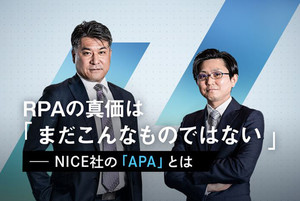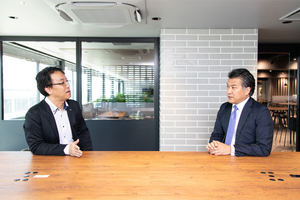Click here to hide this one-time notice.
Job Search

Feature Article
Employer NICE Japan Ltd.

Articles about nice
Technology that overcomes the challenges of RPA. What is NICE's product group "APA"?

"It has taken time to select the tasks to be automated."
"Development in the business division is not progressing, and the project is stuck."
"Every time the specifications of the connection destination site change, the robot causes an error, and it is troublesome to deal with it each time."
Almost five years after RPA (Robotic Process Automation) became a boom, it has become established as a method for improving operational efficiency, but it is not uncommon for users to face the above problems. It can be said that we have entered a stage where a new approach is required, which goes beyond the conventional method of "moving complicated manual work to automatic execution".
Under these circumstances, NICE, which has been developing RPA products for contact center operator support applications from early on, has greatly streamlined the robot development and operation process by applying its specialty data analysis technology. It is expanding its applications to fields other than contact centers.
We asked Mr. Ryuichi Ando, president of Nice Japan Co., Ltd. (Minato-ku, Tokyo), the company's Japanese subsidiary, and Mr. Tomoyuki Mochizuki, the solution consultant manager of the company, about the concept and features of the latest products and business strategies in Japan.
Real-time support tailored to individual skill levels is possible
-NICE's RPA product has established a top-class position globally, such as being evaluated as the best "leader" out of four stages in the latest survey of Forrester Research in the United States. I have the impression. First of all, please tell us about the concept of NICE's RPA and its domestic expansion so far.
Ryuichi Ando (President of Nice Japan Co., Ltd.): NICE is a company with many years of experience in solutions for contact centers such as call recording and voice analysis. Since December, I have been the representative of the Japanese corporation, and I have been involved in business support in the contact center industry for over 20 years.
NICE has a long history in the field of RPA as well as in major vendors, and it was in 2001 that it first provided desktop tools. At a time when the word RPA wasn't there yet, it was called RTPO (Real-time Process Optimization) at that time.
Our RPA products are currently used daily in contact centers of 1,000 people around the world and in Japan, and the Ministry of Internal Affairs and Communications, which accepts license applications for radio stations such as broadcasting, aviation, and mobile phones, has a large number of products. It is also used to improve the efficiency of input work.
Tomoyuki Mochizuki (Manager, Solution Consultant, Company): NICE's RPA, which has evolved as a solution to support contact centers , aims to be "Automation for the People" for employees with different skill levels. In addition, it is characterized by supporting work in real time.
Symbolic in this respect is our desktop RPA product "NEVA". "NEVA" runs in the background and allows you to do other work in parallel on a running terminal. Taking the contact center as an example, during a conversation with a customer, the operator can not only immediately show the information that he / she wants to check according to the conditions on the screen, but also undertake post-processing such as registration work.
In the RPA boom in Japan in recent years, the use in the back office has been highlighted, and I think there has been a strong need for applications that "cut out and replace automated manual work from a series of business flows." However, these uses are a little different from our RPA concept. Therefore, from the perspective of avoiding mismatches, there is a history of refraining from actively appealing that "NICE also has RPA products" in Japan.
-Does that situation or situation change when you come here?
Ando: Yes. Now that the use of robots is increasing outside the back office and our product lineup is enriched, we believe that NICE's RPA has become a suitable option in the Japanese market as well.
By applying AI to the data collection and analysis technology that NICE is good at, it has become possible to improve total work efficiency, such as selection of work to be automated and operation management, in addition to automation itself. I am confident that it will be extremely useful for users who feel that they are not using RPA to their full potential.
Automation Select and implement target business
-Please tell us about the current NICE RPA product lineup and the latest features.
Ando: The packages of RPA products that we collectively call APA (Advanced Process Automation) are the fully automated server-type RPA tool "NICE Robotic Automation" and the desktop-type RPA tool "NEVA" that can be executed as needed. , And "Automation Finder", which is responsible for analyzing and visualizing desktop data and selecting automation targets.
Robot development and management is Web-based, server-type and desktop-type robots can be created with the common "Automation Studio", and real-time monitoring function "Connectivity Watcher" that quickly detects connection errors at runtime is a standard function. It has become.
Mochizuki: APA's latest product, version 7.4, updated in December 2020, adds a new feature to Automation Finder called "Click to Automate."
As an image of utilization, for example, if "the work of accessing multiple systems and putting the aggregated information into the text of the email" is frequently performed in the company, Automation Finder detects that such a process can be automated. , Identify high-priority automation targets based on frequency and processing time.
If you use Click to Automate here, a "template that automates information aggregation and email composition" will be automatically generated with the click of a button. All you have to do is edit the generated template in Automation Studio as appropriate and you can immediately automate all processes of the same kind. By using this function, we believe that we can solve the problems of "I don't know the work to be automated" and "I can't develop in-house".
In addition, I think that tasks with a level of "1 second", which has not been a burden to manual work and has a shortening effect when automated, have hardly been targeted for automation by RPA. However, if many employees in the company repeat such work many times a day, the benefits of robotization are sufficient. Our products enable a new approach to RPA utilization that efficiently collects these unobtrusive “seed” of automation and aims for great results with a small accumulation of effects.
The true value of RPA is "not yet like this"
-It seems that the product can overcome many of the challenges you face while promoting the use of RPA. Can you give us an idea of the environment and cost required for introduction?
Mochizuki: APA collects all kinds of work history from the installed terminal to "keyboard push" in order to obtain the optimum result in business selection and automation template creation. Therefore, you will need to prepare a server environment that can safely store such data on-premises or in the public cloud. Work items that include personal information can be converted to an undecipherable format and excluded from collection and analysis.
In addition, the cloud-based CX platform "CXone", which is scheduled to be released in Japan in July 2021, has an omni-channel routing function and crosses various channels for CX (customer experience) and customer insights. It has a function to understand, analyze, and visualize. Our policy is to further strengthen the functions on the cloud in line with the diversifying work styles.
In terms of cost, it is sold out for each execution license or a monthly fee system, and if you have one execution license for NEVA, which is a desktop tool, Automation Studio, Connectivity Watcher, Automation Finder, etc. are also included as standard functions.
There is no license fee other than the execution environment, and the price is set assuming the case where it is used by thousands or tens of thousands of people like a contact center from installation on one terminal, compared with RPA products of major vendors. Even so, I think that reasonable operation is feasible.
-From the story so far, many readers seem to have felt the considerable potential of APA. Finally, do you have a message for those involved in the spread of RPA?
Mochizuki: Now that the introduction that has been booming has come to an end, I think that some people are looking at the merits of using RPA with a slightly awakened eye. However, the latest evolving technology makes the entire robot utilization cycle easier and more efficient.
What I would like to tell you is that "the true value of RPA is not yet like this ." Especially for those who have "stumbled on RPA in the past and are looking for opportunities to retry", I would like you to touch on the latest features such as Click to Automate.
Ando: We believe that our products will be of great help to users who are steadily introducing RPA in the phase of accelerating in-house production, in that they can select and implement tasks to be automated and reduce the operational burden. increase.
I think the choice of using existing tools and APA together and re-challenge the promotion of RPA utilization with a new approach that makes use of Automation Finder is realistic enough. While strengthening alliances with partners who agree with these policies, we hope that we can expand the latest APA in Japan and contribute as much as possible to the creation of a system for sustainable business improvement.
How can Japanese contact centers make DX successful?

Contact centers have become more important than ever in history as the methods of communication change with the Corona disaster. How should Japanese companies promote digital transformation (DX) of contact centers? Mr. Noriaki Izumi, Director of Architecture Strategy Planning Office, Information Economy Division, Commerce and Information Policy Bureau, Ministry of Economy, Trade and Industry, who wrote "DX Report" and is in charge of DX promotion policy in Japan, and Nice Japan Co., Ltd., which provides a cloud platform for contact centers. We will deliver a dialogue with Mr. Ryuichi Ando, the president of the Japanese corporation.
Still a deep-rooted misunderstanding of DX
Mr. Noriaki Izumi (hereinafter referred to as Mr. Izumi): In 2018, I released the "DX Report" with the desire to inform the world of the need for business transformation centered on IT, but I expect an actual reaction. It was different from what I was doing. Despite appealing that IT should be regarded as a tool for strengthening competitiveness rather than a tool for labor saving and efficiency, DX was received as an opportunity for legacy renewal rather than as an opportunity for business reform. is. This was unexpected.
Mr. Ryuichi Ando (hereinafter referred to as Mr. Ando): There is a "misalignment" in the way of thinking and thinking in the first place. In fact, it is often the case that many companies have set up a DX promotion department, and even if they launch a project, they cannot proceed to full-scale development.
Mr. Izumi: That trend is still going on, and according to a survey and analysis by IPA, only about 8% of companies say that they will work on DX company-wide. In addition, few companies are able to allocate budgets in a well-balanced manner and dispose of unnecessary items when rebuilding the system from the perspective of overall optimization, and most companies have not started DX. It seems to be close to the situation.
Mr. Ando: I feel like I'm stalling too much looking for in-house know-how and precedents as to what to do.
Mr. Izumi: A company's top management describes digital transformation as "a turning point once in 100 years." It is an era of change similar to the Meiji Restoration. Did the people who were active at the end of the Tokugawa shogunate rely on consulting and precedents? As long as the existing IT is added to the current management, it will remain the old management. New management is born only when the management style is changed around the new IT symbolized by the term digital.
"Analytical power" evolves contact center
Mr. Ando: The need for contact centers is dramatically increasing due to the decrease in customer contact points due to the corona disaster. It may be the time when the number of operators is the largest in history. How do you improve efficiency while working from home? Where should AI chatbots be introduced? While the study has begun, there seems to be a temperature difference in the movement to renew customer service itself with the power of digital.
I believe that hospitality is science. I think the time has come to further refine the traditional corporate culture by clarifying and digitizing the customer's image and analyzing it instead of numerical management.
Mr. Izumi: I'm also a scholar in my previous job, so I'm very impressed with that attitude toward analysis. It is important not to use the word "hospitality" as a mere label, but to be able to paraphrase it concretely and to put it into the real image of management.
You said "analysis, not numerical management", but just looking at the numbers regularly, for example, in a health checkup, is not management. It is best to formulate and practice hypotheses such as "yoga is good for health" and "half-body bathing is effective", evaluate the effects by changing numbers, and utilize them in the next hypothesis planning. ..
Mr. Ando: With the advancement of technology, the level and speed of handling data is steadily increasing. By multiplying the speed from hypothesis planning to cross analysis, new values such as "our weakness, isn't this really this?" And "maybe this was actually a strength" can be seen.
Mr. Izumi: “Should we really be in charge of building infrastructure for customer analysis directly?” May be a point that each company should consider.
For example, in Kansai, an aunt at a train station may not sell you even if you just say "canned coffee." You will be asked what you want by saying, "I have some milk" and "Is it okay if I have a lot of milk?" Speaking of sushi, it's sushi, but it's also good marketing. On the other hand, at the station shops in the Kanto area, automation is steadily progressing, not just conversation.
It's not about which is better, east or west, but it's about deciding whether or not to listen to the customer's voice. It is important to decide for yourself whether it is a core business or a non-core business, a competitive area or a non-competitive area.
I'm currently compiling "DX Report 2.1", and I'm going to show "addition DX" and "subtraction DX" there.
Incorporate the idea of IT into management instead of adding IT to management
Mr. Ando: A very interesting keyword came out. What are the ideas of "addition DX" and "subtraction DX"?
Mr. Izumi: If building a new business with cutting-edge technology is "addition DX," then by using a multi-sided platform, separating the operations that we were doing is "subtraction DX." is.
For example, security is an important issue for any company, but you have the option of using SOC services instead of doing everything yourself. Not only expanding everything, but also deciding the area where you can split the bill is a scene where you can demonstrate your management sense.
Mr. Ando: It's DX, including letting go. I've heard from a customer who is working toward DX at a contact center that it's important to take it off with courage if you get stuck in one thing.
Mr. Izumi: That's a very nice way of thinking. How many people are attached to their business? While developing the core area by ourselves, the other parts will function by API linkage. I think that management should incorporate this idea of modern IT.
Mr. Ando: There seems to be a fear of "subtraction DX" in the field, such as "I think there will be no work due to efficiency improvement." It will be important to show the concrete future of what kind of career advancement each individual will lead to by utilizing digital technology.
Mr. Izumi: Top-down is effective as an approach in the early days of the company, and bottom-up is effective as an approach when it matures to some extent, but in such a major turning point, a "middle-out" mechanism is required. It is not enough for the top management to just say the vision or to improve each theory in the field. Based on the central concept, we will show a huge and concrete blueprint.
I think that the Ministry of Economy, Trade and Industry also needs to show changes in an attitude rather than saying something from the top. The "DX Report" will not be released every few years, but will be updated steadily to spread the "Japanese DX standard package".
Ando: I'm looking forward to it. With cloud technology, we at Nice Japan are now able to deliver IT solutions not only to large companies but also to small and medium-sized companies in rural areas. Going forward, we will continue to support DX at contact centers in Japan from the perspective of "analysis," with the spirit that it is sometimes necessary to encourage DX for subtraction.


















